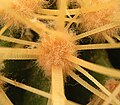Areole
Areoles are a characteristic and always present feature of two closely related plant families , the cactus family (Cactaceae) and the Didiereaceae . They can be developmentally on in the leaf axils formed short shoots traced. In the course of the evolution of plants, the leaves were reduced in number and size in order to reduce the evaporation surface and turned into thorns to ward off predators .
Areoles of the Didiereaceae
The bare areoles of Didiereaceae form warty elevations from which leaves and thorns arise. You can still see their origin from short shoots.
Areoles of cacti
The areoles of the cacti are circular to oblong oval, felt-like pads, from which thorns and often hair and bristles usually arise.
- The species of the originally appearing genus Pereskia (subfamily Pereskioideae) produce normal leaves from the hairy areoles in addition to thorns.
- In the subfamily Opuntioideae , the areoles have very fine, barbed thorns, the so-called glochids , as well as short-lived, awl-shaped leaves, in addition to the normal thorns that are not always formed .
- The species of the subfamily Cactoideae are completely leafless. In most genera, the areoles give rise to both branches and flowers . In Mammillaria and closely related genera, flower formation is relocated to the axillae . These are located between the areola-bearing warts, are also felty and often have hair and bristles. In some genera such as Ariocarpus , the separation of the areole and axilla is incomplete, then they are connected to one another by a furrow.
Areoles of Myrtillocactus geometrizans .
Areole of Echinocactus grusonii .
Areoles of Pereskia grandifolia .
Mammillaria marksiana with thorn-bearing areoles on the warts and white, felty axillae in between.
Web links
Individual evidence
- ↑ Werner Rauh , The 100 Most Beautiful Cacti , Humboldt-Taschenbuchverlag, 1980, ISBN 3-581-66370-8



